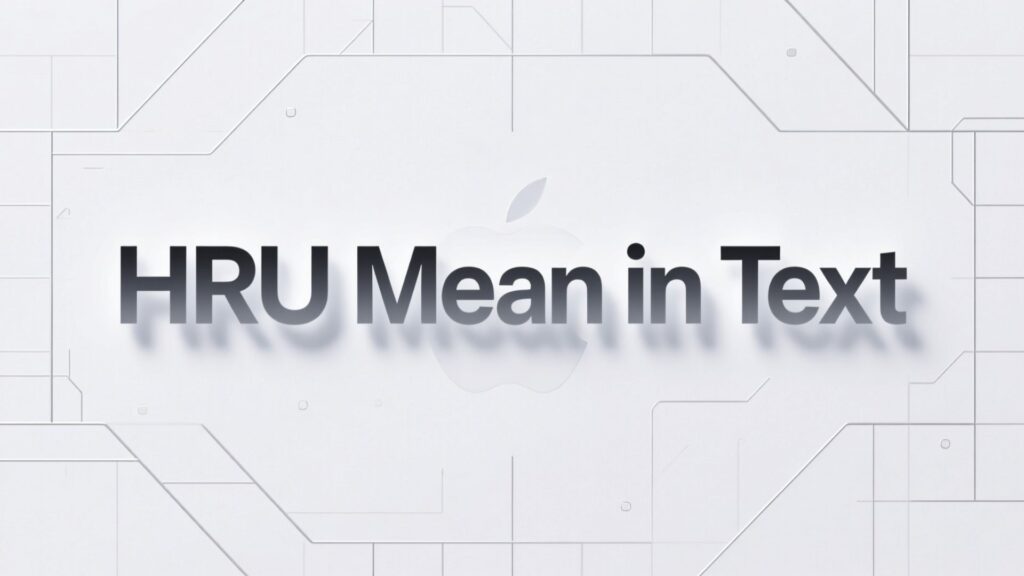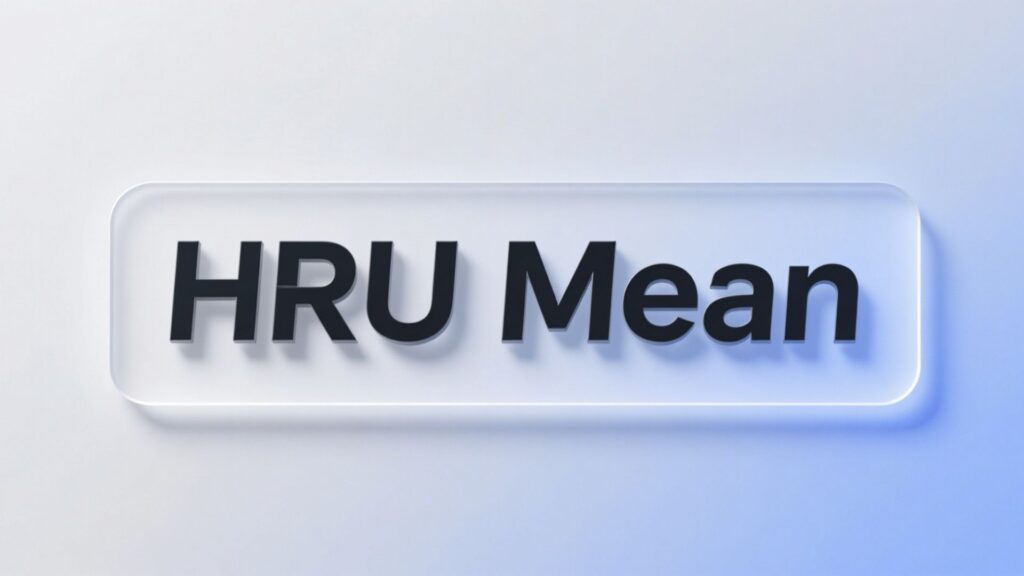Texting has changed the way people connect. From short abbreviations to emojis, our screens are filled with creative shortcuts. One of the most common ones you’ve probably seen is HRU. But what does HRU mean in text, and why does everyone use it? In this complete guide, you’ll learn the HRU meaning in text, its variations, tone, best replies, and smarter alternatives for every situation in 2025.
The Rise of Texting Slang in 2025

Texting slang didn’t start yesterday it evolved with technology. When phones first had limited characters, users found ways to express more with less. That’s how abbreviations like “LOL,” “BRB,” and “HRU” became part of digital culture.
Today, HRU in text is a staple across apps like Snapchat, Instagram, WhatsApp, and TikTok. With the rise of Gen Z and Gen Alpha communication styles, acronyms like HRU help keep chats short, fast, and casual. In 2025, understanding these terms is more than a trend it’s essential digital literacy.
Fun fact: The average person now sends over 40 short-form messages a day, most containing at least one abbreviation or emoji.
What Does HRU Mean in Text?
The acronym HRU simply stands for “How are you?”. It’s a friendly, fast way to check in with someone through a text or social message.
You’ll often see HRU used when someone wants to start a casual conversation without sounding too formal. It keeps things light, friendly, and approachable.
Examples:
- Friend A: “HRU?”
Friend B: “Doing great, just finished my workout.” - Coworker: “Hey, HRU holding up with the project?”
Reply: “It’s going well, thanks for asking!”
Origin of HRU
The HRU meaning in text traces back to the early 2000s, during the rise of SMS texting. With old phones allowing only 160 characters per message, people began shortening phrases to save space and time.
By 2010, HRU had spread across social platforms like Facebook Messenger and Twitter. In 2025, it’s more versatile than ever used in memes, captions, and even voice-to-text messages.
Why Understanding Texting Acronyms Like HRU Matters
Texting acronyms like HRU are part of modern digital communication. Understanding them helps you:
- Avoid misunderstandings: Knowing tone and context ensures your message is received as intended.
- Connect better: Using familiar slang helps you bond with friends or peers naturally.
- Adapt across platforms: HRU on Snapchat feels casual, but on a work chat, it can feel too informal.
Case Study: A Digital Misunderstanding
Jenna, a college student, texted her new study partner, “HRU?” expecting a casual conversation. He replied with a lengthy professional message thinking it was a formal check-in. The mismatch in tone made things awkward.
The takeaway? The same phrase can carry different tones depending on the relationship and context. That’s why understanding nuance is key.
When Should You Use HRU?
You can use HRU when you’re chatting casually or checking in with someone informally. It’s ideal for friendly conversations, light check-ins, or reconnecting with someone you haven’t texted in a while.
However, you should avoid HRU in formal or professional settings, such as business emails or job applications.
Best Places to Use HRU:
- Text messages: Perfect for quick personal chats.
- Snapchat or Instagram DMs: Common among friends or followers.
- Online dating apps: Helps start a light-hearted, friendly conversation.
When Not to Use HRU:
- In emails to clients or supervisors.
- During formal online interviews.
- In text chains where tone could be misread.
Platform-Based Etiquette Table
| Platform | HRU Usage | Tone Example |
|---|---|---|
| Snapchat | Very common | “HRU? Haven’t seen your story lately 😄” |
| Instagram DM | Friendly | “Hey! HRU? Loved your recent post.” |
| Casual | “Morning! HRU today?” | |
| Not recommended | Use “How have you been?” instead. |
Alternatives to HRU for Different Contexts
Sometimes HRU might not fit the tone you want. Here are some better ways to ask how are you depending on your situation.
Casual & Friendly Alternatives
Use these with friends or people you chat with often.
- “How’s it going?”
- “What’s up?”
- “How’ve you been?”
- “How’s life treating you?”
- “Sup?”
Kind & Warmhearted Alternatives
These show genuine care or empathy.
- “How are you holding up?”
- “How’s your day so far?”
- “Hope you’re doing okay.”
- “You’ve been on my mind how’s everything?”
Professional or Polite Alternatives
Use these in emails, business texts, or formal messages.
- “How have you been?”
- “I hope you’re doing well.”
- “How are things on your end?”
- “Hope your week’s going smoothly.”
Tone Comparison Table
| Type | Example | When to Use | Tone |
|---|---|---|---|
| Friendly | “What’s up?” | Friends, peers | Playful |
| Warmhearted | “How’s your day?” | Close friends, family | Caring |
| Professional | “Hope you’re doing well.” | Colleagues, clients | Polite and formal |
The Nuance of Tone: Why “How Are You?” Isn’t One-Size-Fits-All
Language carries emotion. The same question can sound caring, indifferent, or even sarcastic depending on tone and context.
For instance, “HRU?” can mean:
- A polite check-in.
- A flirty opener.
- A casual greeting.
Tone Shifts Based on Expression
| Phrase | Possible Meaning |
|---|---|
| “HRU?” | Casual check-in |
| “HRU 😊” | Warm and kind |
| “HRU???” | Impatient or annoyed |
| “HRU lol” | Playful or teasing |
Generational and Cultural Differences
Younger generations (like Gen Z) use HRU frequently, while older adults may prefer “How are you?” or “How have you been?” Some cultures value formal greetings more, making HRU seem too casual.
Example: In Japanese or Korean texting culture, formal respect-based greetings are still preferred.
That’s why understanding your audience helps maintain tone balance in any conversation.
How to Respond to HRU: 15 Reply Examples for Every Situation

You’ve just received a text saying “HRU?” What’s the best way to reply? Your answer depends on mood, relationship, and situation.
Simple & Direct Replies
- “Good, you?”
- “I’m okay, thanks for asking!”
- “Doing fine, just relaxing.”
Funny or Playful Replies
- “Surviving on coffee and memes, you?”
- “Still waiting for Friday to arrive 😅”
- “Same old chaos, different day!”
Flirty Replies
- “Better now that you texted 😉”
- “Could be better unless you’re free tonight?”
- “HRU? You’ve been on my mind lately.”
Honest or Real Replies
- “Not great today, but thanks for checking in.”
- “It’s been a rough week. How about you?”
- “Doing better than yesterday, thankfully.”
Professional Replies
- “Doing well, thank you. Hope you’re fine too.”
- “All good here, busy as usual!”
- “I’m fine, just working through some deadlines.”
Table of Example Scenarios
| Situation | Example Reply | Tone |
|---|---|---|
| Friend | “Good, you?” | Casual |
| Romantic | “Better now that you texted 😉” | Flirty |
| Professional | “Doing well, thank you.” | Formal |
| Stressful day | “Not the best, but I’ll be okay.” | Honest |
Advanced Tips for Choosing the Right Phrase
Selecting the right way to ask or answer what does HRU mean conversations isn’t random it’s thoughtful communication. Here’s how to make each message feel more authentic and effective.
Match Tone to Relationship
Be casual with friends and polite with coworkers. Your phrasing should reflect your connection.
Read Emotional Cues
If someone sounds down, respond warmly instead of keeping it dry.
Example:
Instead of “Good, you?”
Try “I’m okay! You’ve been quiet lately, everything alright?”
Be Specific
Generic answers like “fine” or “good” feel robotic. Add small details to make your replies engaging.
- “I’m good, just finished a long shift.”
- “Feeling tired but accomplished!”
Respond with Authenticity
Honesty builds trust. People appreciate real emotions over rehearsed lines.
Use Names
Mentioning names personalizes your message.
“Doing great, Sarah! How’s your weekend going?”
Common Mistakes to Avoid When Using HRU
Even though HRU seems simple, small mistakes can change its tone. Avoid these pitfalls to keep your chats natural and engaging.
- Overusing slang: Using HRU in professional or serious conversations can sound careless.
- One-word replies: “Good” or “Fine” can end a conversation fast.
- Poor timing: Don’t send “HRU?” during odd hours or sensitive moments.
- Ignoring context: Not everyone knows texting slang; older family members might find it confusing.
- Tone misfires: Sending “HRU???” can sound confrontational.
Pro Tip: If unsure about tone, spell it out fully as “How are you?” It’s safer and more universally understood.
How HRU Reflects Evolving Digital Communication in 2025
Language changes with technology. In 2025, HRU symbolizes the speed and adaptability of human conversation online.
Trends Driving HRU’s Popularity
- Efficiency: People text fast; brevity saves time.
- Personalization: Emojis and abbreviations make texts feel casual yet expressive.
- Cross-platform slang: HRU is used across TikTok, Snapchat, Discord, and Instagram.
AI and Autocorrect Influence
Modern AI keyboards predict and suggest slang like HRU automatically. Messaging apps like WhatsApp now adapt replies like:
“HRU?” → Auto-suggestion: “I’m good, you?”
Emerging Alternatives in 2025
Newer shorthand expressions are rising alongside HRU:
- “HBU” – How ‘bout you?
- “HYD” – How’s your day?
- “SUP” – What’s up?
- “HRN” – How’s right now? (new trend seen in Gen Z slang)
Voice and Emoji Replacements
People increasingly replace HRU texts with:
- Voice notes: “Hey, just checking in how are you doing?”
- Emojis: “👋😊” conveys the same warmth as HRU.
Prediction: By 2026, quick audio or visual greetings may outnumber text-based HRU messages.
Final Thoughts: Language That Builds Connection
At first glance, HRU in text may seem like just three letters but it represents more. It’s a small gesture that opens doors for connection, empathy, and communication in our fast-paced world.
When someone texts HRU, they’re reaching out in their own way. Whether you reply with humor, honesty, or care, your words can turn a brief exchange into a meaningful moment.
Takeaway:
Even a simple “HRU?” carries emotional weight. Choose your tone wisely, respond authentically, and let your messages reflect who you truly are.
Quick Reference Summary Table
| Context | Recommended Phrase | Example Response |
|---|---|---|
| Friendly Chat | “HRU?” | “I’m great! How about you?” |
| Professional | “How have you been?” | “Doing well, thank you.” |
| Romantic | “HRU 😘” | “Better now that you texted!” |
| Concerned | “How are you holding up?” | “Thanks for asking, hanging in there.” |
Key Takeaways
- HRU means “How are you?” and is used in casual digital communication.
- Choose tone and platform carefully to avoid misunderstandings.
- Use authentic replies to keep conversations alive.
- Explore alternatives when texting professionals or expressing deeper emotion.
- Communication trends show HRU’s lasting influence even in 2025’s AI-driven world.
In short:
When you see “HRU”, it’s not just slang it’s an invitation to connect. So the next time someone asks what does HRU mean on Snapchat, you’ll know it’s more than letters. It’s today’s shorthand for care, curiosity, and human connection.
Bugti is the founder of Quoethint.com, a hub for English language tips, writing advice, and grammar guidance. With years of experience in English studies and a passion for clear communication, Bugti created this platform to make grammar and writing easy to understand for everyone.
